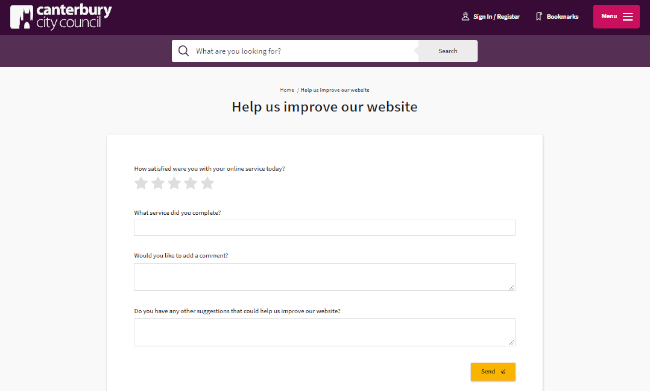Governmental and nonprofit organisations deal with considerable amounts of data. Taxes, unemployment, immigration, impact stories, event registrations, financial data, etc. The list is long. Naturally, this creates a lot of content… as in loads! While posting this sort of information on a website or in a newsletter is an efficient way of reaching a large audience, it does leave a few questions. Like how can you be sure that your website visitors are finding what they are looking for?
The short answer is: You can’t. Unless you actually talk to the people who interact with your information.
One of the most significant issues the public sector has, when creating online services, is ensuring that information is helpful and/or easy to find. The key to success is improving the customer experience. And this starts with collecting feedback!
In this blog, we will look at four ways in which user feedback can help governmental and nonprofit organisations improve their customer experiences.
1. Asking for feedback gives your visitors a voice
Without feedback, deciding what information is important to website or app visitors turns into a guessing game. By asking users and visitors for their thoughts on the information they consume, it is easy to pinpoint:
- If they are finding what they are looking for.
- If the content on a website, an app, or in a specific email is helpful.
In other words, user feedback helps you improve everything from your tone of voice to your website structure.
For example, let’s say you have just lost your job (oh no!) and need to sign up for unemployment benefits. Seems like a simple task! But anyone who has ever been unemployed can tell you what a vast, taxing experience this can be.

Finding the correct form, on the right page, and even the right website, can be a massive job. If the information isn’t easy to find, it doesn’t matter if it’s there or how well it is written. Asking for customer feedback is the perfect (and only) way to get insights on how you can make this journey easier for your customers.
A good indication of what your customers think of your content is your customer effort score (CES). This metric allows you to measure the ease of an online experience. You create it by asking for input with the help of a feedback software.
2. Customer feedback helps to create higher performing content from the start
The benefit of knowing where your weaknesses are is that you can fix them! Planning and developing an online service takes a long time. And it is usually based on assumptions.
In an interview with Mopinion, David Newell, Product manager at Canterbury City Council, spoke about what assumption-based online services can lead to:
“When you work like this, not only are you unlikely to deliver something useful for anyone, but because you’ve spent so much time and effort getting it live, there probably won’t be any changes or improvements made for years.”
David Newell, Canterbury City Council

By implementing feedback into the process, you can make sure that your end product will be useful from the start. Combining operational data with feedback, also makes it easy to see exactly which actions you need to take to deliver an outstanding customer experience. This improvement comes with many more benefits, of course! Research shows that enhancing the public sector customer experience:
- boosts trust in government and loyalty towards nonprofits.
- minimizes the risk of negative media coverage.
- lowers costs for government agencies.
- reduces mistakes and questions for customer service.
Asking for customer feedback also promotes these values by encouraging openness and transparency.
3. Creating content based on feedback saves time for everyone
Let’s go back to our unemployment example! You managed to sign up for benefits, but now you have questions about what is expected of you while looking for a new job. The information you need is spread over two different websites, in multiple articles, and videos. You become anxious that you might have missed something. So you give the organisation a call.
It doesn’t take long for the customer service team to give you a clear answer. But imagine that you get hundreds of phone calls with the same question every day. This time builds up, and it could easily be reduced by an optimised customer journey.
The same applies to nonprofits. Imagine wanting to help out a great cause like The Ocean Cleanup. You are in the moment of action, so their website must provide you with an easy journey to sign up and help them out. Luckily they do. But it’s easy to mess this vital step up. You can’t know which steps you are missing based on data alone. That is why it’s so important that you ask your users, customers, and visitors what they need.
Creating content that is helpful and easy to find, results in fewer queries. In turn, customers will have a painless experience and make fewer mistakes. Websites, emails, or apps from nonprofits or organisations within the public sector are also perfect for feedback tools as they have a significant number of readers. Improve your user and customer journey with feedback, optimised for government and nonprofit.

Ready to start collecting feedback?
4. Measure the success of your messages
Opinion polls, campaigns, crisis communications, warnings for the public, etc. Governmental and nonprofit organisations deal with many different messages. But it can be hard to measure how the public feels about them until months later.

Using feedback software to collect input is an easy way to see if you need to tweak a word here or there. Or perhaps scrap the whole campaign. Together with operational data, user feedback can also lead to insights into what specifically didn’t work. For example, perhaps you have a campaign that was appreciated but didn’t get the reach you wanted. So you change the channel for the campaign and poof! Suddenly it is a big success. Without asking for customer feedback you wouldn’t know that the campaign was worth sticking with.
The combination of quantitative and qualitative data gives insights into what you can do to get the most out of your messaging.
Start optimising your communication today
As digitalisation progresses, customers will keep expecting more and more from the public sector. According to the EU, 58% of all people aged 16-74 in the European Union interacted with public authorities online in 2021. With digital customer-focused services like Uber, Netflix, and Spotify becoming more common, the bar for nonprofit and governmental organisations’ customer service is set higher. The first step to a better customer journey and overall experience is finding the right feedback software for your needs.
Ready to get started? Want to learn more about Mopinion’s all-in-1 user feedback platform? Don’t be shy and take our software for a spin! Do you prefer it a bit more personal? Just book a demo. One of our feedback pro’s will guide you through the software and answer any questions you may have.
Ready to see Mopinion in action?






